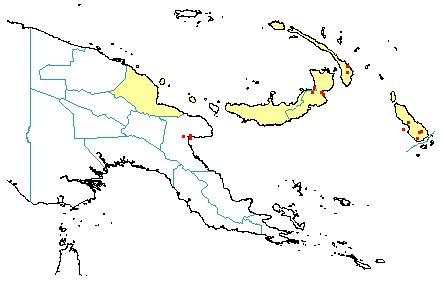
in PNGplants database
PNGTreesKey – Terminalia brassii Exell |
Barry Conn (NSW) & Kipiro Damas (LAE).
Guide to trees of Papua New Guinea
Copyright held by the authors, National Herbarium of New South Wales, and Papua New Guinea National Herbarium
Journal of Botany Vol. 73: 134 (1935)
Other Literature: M.J.E. Coode, Handbooks of the Flora of Papua New Guinea 65 (1978) Fig. 25.
Family: Combretaceae
Dicotyledon
Timber Group: Major exportable hardwood Tradename: Brown Terminalia
Field Characters: Large canopy tree (20-50 m high); Bole cylindrical (45-200 cm diam.); straight (sometimes branching from near base); buttresses buttresses present (branched near ground); spines spines absent; aerial roots aerial roots absent; stilt roots stilt roots present (in very swampy conditions); Bark brown, rough, scaly or flaky (in large long scales); Subrhytidome (under-bark) pale red; less than 25 mm thick, 18.0-20.0; bark blaze with two layers; faintly to non-aromatic; pleasant; outer blaze pink or pale brown, markings absent, fibrous; inner blaze pink, markings absent, fibrous; bark exudate (sap) present, colourless, not readily flowing (spotty), colour changing on exposure to air, to brown, not sticky; terminal buds not enclosed by leaves.
Indumentum: Complex hairs absent; stinging hairs absent; mature twig indumentum (hairs) present, hairs dense.
Leaves: Leaves spaced along branches, opposite (in pairs, opposite one another on the branchlet) (subopposite) or spiral (leaves occurring singly at a node and arranged spirally up the branchlet), simple (a leaf composed of a single blade); petiole present (with two prominent glands near base of lamina), not winged, attached to base of leaf blade, swollen (with gland at base); leaves equally broad throughout much of length, 10.0-19.0 cm, 4.5-6.0 cm; symmetric, entire, not dissected or lobed, sub acute or acuminate (shortly), venation pinnate, secondary veins open, prominent, intramarginal veins absent; leaves lower surface green (with rusty-red coloured hairs when young), upper surface green (glossy), indumentum (hairs) present (on young leaves), indumentum (hairs) dense or sparse; present; domatia present, scattered across lamina (along margin of lower surface); stipules absent.
Flowers: Inflorescence terminal or axillary, flowers on a branched axis, cones absent; flowers bisexual, stalked, flowers with many planes of symmetry, 6.0-7.0 mm long, diameter small (up to10 mm diam.) (c. 3 mm diam.); perianth present, with all sepals and/or petals (hence tepals) similar, inner perianth white; 5, some or partly joined; stamens 8-10, present, free of each other, free of the perianth; ovary inferior, carpels joined (when more than one), locules 1; styles solitary, 1.
Fruits: Infrutescence arranged on branched axis, fruit 12.0-18.0 mm long, white when mature or green (pale (silvery), not spiny, non-fleshy, simple (winged), indehiscent, drupe (dry, papery); seeds 1, to about 5 mm long (c. 5 mm long), winged (wings 4-6 mm long), narrow (longer than wide), seed 1-10 mm diam. (c. 2 mm diam.).
Distribution: Madang (Cultivated), Morobe (Cultivated), New Britain, New Ireland & Bougainville.
 | Botanical records in PNGplants database |
Notes: Notes This species is readily identified by the present of a pair of distinct glands on the distal parts of the petiole (near the base of the lamina). However, one collection from Bougainville (NGF16348), which is thought to be this species, does not have a pair of glands on most leaves.